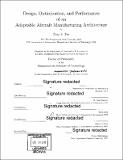| dc.contributor.advisor | R. John Hansman. | en_US |
| dc.contributor.author | Tao, Tony S. (Tony Shuo) | en_US |
| dc.contributor.other | Massachusetts Institute of Technology. Department of Aeronautics and Astronautics. | en_US |
| dc.date.accessioned | 2019-02-14T15:50:35Z | |
| dc.date.available | 2019-02-14T15:50:35Z | |
| dc.date.copyright | 2018 | en_US |
| dc.date.issued | 2018 | en_US |
| dc.identifier.uri | http://hdl.handle.net/1721.1/120427 | |
| dc.description | Thesis: Ph. D., Massachusetts Institute of Technology, Department of Aeronautics and Astronautics, 2018. | en_US |
| dc.description | Cataloged from PDF version of thesis. | en_US |
| dc.description | Includes bibliographical references (pages 101-103). | en_US |
| dc.description.abstract | The cost and time required to develop aircraft have grown strongly over time, to the point where aircraft have become prohibitively expensive and are outpaced by ever-evolving mission needs. To address this problem, this thesis presents and explores an aircraft platform architecture called "Adaptable Aircraft Manufacturing" or "AAM", which features common tooling geometry that enables the creation of any composite aircraft (within a reachable subspace) on demand. To prove the feasibility of this architecture, a family of aircraft was constructed using a single set of AAM tooling. This thesis also optimizes the AAM geometry and quantifies the inefficiencies incurred by its adoption. This family optimization problem is both logically and computationally complex since the constraints AAM places between the variants cannot be prescribed by the designer, but arise as a result of the optimization gradients that exist between variants. A sequential-process framework which clarifies the relations and points of adjustability available in aircraft manufacturing is presented. A signomial-programming (SP) aircraft optimization code that is capable of simulating the inefficiencies generated by the AAM geometry was developed. The SP mathematical structure and the GPkit codebase were selected due to their compatibility with the constraint-heavy geometric rules that describe AAM and for the rapid speed of computation, which is necessary due to the scale of the optimization problem. To quantify the performance of AAM, a series of explorations are conducted whereby the performance of an AAM-family of aircraft is compared against a fleet of Individually-Optimal (IO) aircraft. These explorations are conducted along the axes of payload size, cruise speed, mission scope, and market bias to gain an understanding of how (and by how much) the AAM constraints affect both the performance and the geometry of the aircraft it produces. The results show that, for total-mission-cost-minimizing fleets of three designs each, the AAM fleet is between 10 and 20% more costly, but only require between 30% and 80% the tooling as an 10 fleet. | en_US |
| dc.description.statementofresponsibility | by Tony S. Tao. | en_US |
| dc.format.extent | 109 pages | en_US |
| dc.language.iso | eng | en_US |
| dc.publisher | Massachusetts Institute of Technology | en_US |
| dc.rights | MIT theses are protected by copyright. They may be viewed, downloaded, or printed from this source but further reproduction or distribution in any format is prohibited without written permission. | en_US |
| dc.rights.uri | http://dspace.mit.edu/handle/1721.1/7582 | en_US |
| dc.subject | Aeronautics and Astronautics. | en_US |
| dc.title | Design, optimization, and performance of an adaptable aircraft manufacturing architecture | en_US |
| dc.type | Thesis | en_US |
| dc.description.degree | Ph. D. | en_US |
| dc.contributor.department | Massachusetts Institute of Technology. Department of Aeronautics and Astronautics | |
| dc.identifier.oclc | 1084480621 | en_US |
